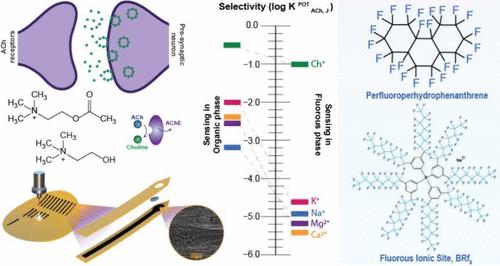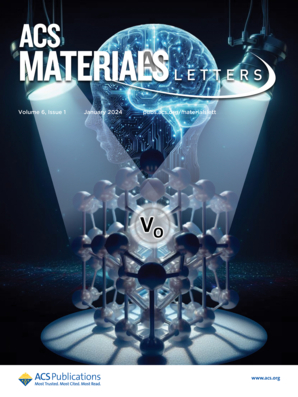Flexible Acetylcholine Neural Probe with a Hydrophobic Laser-Induced Graphene Electrode and a Fluorous-Phase Sensing Membrane
IF 8.7
1区 化学
Q1 MATERIALS SCIENCE, MULTIDISCIPLINARY
引用次数: 0
Abstract
This work develops the first laser-induced graphene (LIG)-based electrochemical sensor with a superhydrophobic fluorous membrane for a flexible acetylcholine (ACh) sensor. ACh regulates several physiological functions, including synaptic transmission and glandular secretion. The ACh sensing membrane is doped with a fluorophilic cation-exchanger that can selectively measure ACh based on the inherent selectivity of the fluorous phase for hydrophobic ions, such as ACh. The fluorous-phase sensor improves the selectivity for ACh over Na+ and K+ by 2 orders of magnitude (compared to traditional lipophilic membranes), thus lowering the detection limit in artificial cerebrospinal fluid (aCSF) from 331 to 0.38 μM, thereby allowing measurement in physiologically relevant ranges of ACh. Engraving LIG under argon creates a hydrophobic surface with a 133.7° contact angle, which minimizes the formation of a water layer. The flexible solid-contact LIG fluorous sensor exhibited a slope of 59.3 mV/decade in aCSF and retained function after 20 bending cycles, thereby paving the way for studying ACh’s role in memory and neurodegenerative diseases.

具有疏水性激光诱导石墨烯电极和氟相传感膜的柔性乙酰胆碱神经探针
这项研究首次开发了基于激光诱导石墨烯(LIG)的电化学传感器,该传感器具有超疏水荧光膜,可用于柔性乙酰胆碱(ACh)传感器。乙酰胆碱调节多种生理功能,包括突触传递和腺体分泌。乙酰胆碱传感膜掺杂了一种亲氟阳离子交换剂,该交换剂可根据荧光相对乙酰胆碱等疏水性离子的固有选择性来选择性地测量乙酰胆碱。与传统的亲脂性膜相比,荧光相传感器对 ACh 的选择性比对 Na+ 和 K+ 的选择性提高了 2 个数量级,从而将人工脑脊液 (aCSF) 中的检测限从 331 μM 降至 0.38 μM,从而可以测量生理范围内的 ACh。在氩气环境下雕刻 LIG 可形成接触角为 133.7° 的疏水表面,从而最大程度地减少了水层的形成。柔性固体接触式 LIG 萤光传感器在 aCSF 中的斜率为 59.3 mV/decade,并且在 20 次弯曲循环后仍能保持功能,从而为研究 ACh 在记忆和神经退行性疾病中的作用铺平了道路。
本文章由计算机程序翻译,如有差异,请以英文原文为准。
求助全文
约1分钟内获得全文
求助全文
来源期刊

ACS Materials Letters
MATERIALS SCIENCE, MULTIDISCIPLINARY-
CiteScore
14.60
自引率
3.50%
发文量
261
期刊介绍:
ACS Materials Letters is a journal that publishes high-quality and urgent papers at the forefront of fundamental and applied research in the field of materials science. It aims to bridge the gap between materials and other disciplines such as chemistry, engineering, and biology. The journal encourages multidisciplinary and innovative research that addresses global challenges. Papers submitted to ACS Materials Letters should clearly demonstrate the need for rapid disclosure of key results. The journal is interested in various areas including the design, synthesis, characterization, and evaluation of emerging materials, understanding the relationships between structure, property, and performance, as well as developing materials for applications in energy, environment, biomedical, electronics, and catalysis. The journal has a 2-year impact factor of 11.4 and is dedicated to publishing transformative materials research with fast processing times. The editors and staff of ACS Materials Letters actively participate in major scientific conferences and engage closely with readers and authors. The journal also maintains an active presence on social media to provide authors with greater visibility.
 求助内容:
求助内容: 应助结果提醒方式:
应助结果提醒方式:


